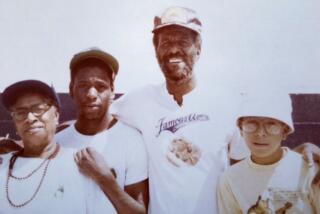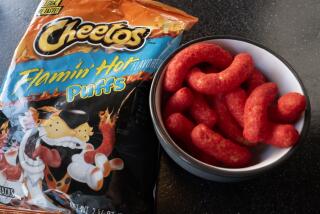American Sweets : Fabulous Fakes
- Share via
I love Mrs. Fields’ chocolate chip cookies, so when I thought I had the authentic recipe for those gooey delights, I was anxious to whip up a batch of the best cookies on earth.
Whoever put the recipe to paper claimed it came straight from Mrs. Fields’ kitchen, so I figured it had to be great. But it didn’t take long--10 minutes at 375 degrees--to discover I’d been had. I was just one of many thousands of people who had been suckered into believing that a multimillion-dollar company had sold its most valuable secret formula.
So, having loads of free time on my hands, I decided to try to figure the recipe out myself. Shouldn’t be too hard, I thought, probably just a couple of hours. Well, those hours turned into a year before I finally had a recipe that tasted just like the real thing.
During the next five years, I became obsessed with this challenge. Like eating potato chips--one just wasn’t enough.
I moved on to McDonald’s Big Mac, analyzing the stacking order, figuring out the special sauce and how to make the middle bun. Then Twinkies, Snickers, Cracker Jack, Kahlua, on and on until I eventually had around 50 recipes for brand-name products that tasted and looked just like their corporate counterpart.
What I really had was a book. That, and a dog grown fat off my fast-food failures.
The big difference between my recipes and the bogus chocolate chip cookies that got me started is that I’ve never claimed these are the actual secret formulas. I just set out to develop methods we can all use to make treats that taste like the originals and are made from ingredients we can buy in any supermarket. We do it so we have control over the ingredients, so we can keep out the preservatives--and because it is fun.
*
In 1975, 18-year-old Debra Sivyer perfected the chocolate chip cookies she had been making since age 12. Little did she know then that her delicious cookies would soon launch her into a successful career with her own multimillion - dollar business. It happened two years later, when her new husband, financial consultant Randy Fields, noticed that his clients couldn’t resist the batches of cookies his wife sent to work with him. With the help of Randy and a banker who lent her $50,000 because he loved her chocolate chip cookies so much, she opened her first cookie store, in Palo Alto, Calif., in 1977. There are now more than 600 stores worldwide.
CHOCOLATE CHIP COOKIES 1 cup butter, softened 1/2 cup granulated sugar 1 1/2 cups brown sugar, packed 2 eggs 2 1/2 teaspoons vanilla 2 1/2 cups flour 3/4 teaspoon salt 1 teaspoon baking powder 1 teaspoon baking soda 1 1/2 (12-ounce) packages semisweet chocolate chips
Cream together butter, sugars, eggs and vanilla in large mixing bowl until well blended.
Sift together flour, salt, baking powder and baking soda in separate bowl.
Add dry ingredients to butter mixture, mixing well. Stir in chocolate chips.
With fingers, form dough into golf-ball-sized portions and arrange 2 inches apart on ungreased baking sheets. Bake at 350 degrees until edges of cookies are light brown, about 9 minutes. Remove from baking sheets to wire racks after slightly cooled. Makes 30 cookies.
Note: It is important that you not exceed cooking time given above, even if cookies appear to be underbaked. When cookies are removed from oven, the sugar in them will stay hot and continue the cooking process. The finished product should be soft in the middle and crunchy around the edges.
Variations:
For variations of this cookie, substitute milk chocolate for semisweet chocolate and/or add 1 1/2 cups chopped walnuts or macadamia nuts before baking. Although you can substitute margarine for butter in this recipe, you will have best results from butter. Cookie will have richer taste and will be crisper around edges, like original.
*
The Twinkie was invented in 1930 by the late James A. Dewar, then the Chicago-area regional manager of Continental Baking Co . , the parent corporation behind the Hostess trademark. At the time, Continental made “Little Short Cake Fingers” only during the six-week strawberry season, and Dewar realized that the aluminum pans in which the cakes were baked sat idle the rest of the year. He came up with the idea of injecting the little cakes with a creamy filling to make them a year-round product and decided to charge a nickel for a package of two.
But Dewar couldn’t come up with a catchy name for the treat--that is, until he set out on a business trip to St. Louis. Along the road he saw a sign for Twinkle Toe Shoes, and the name Twinkies evolved. Sales took off, and Dewar reportedly ate two Twinkies every day for much of his life. He died in 1985.
The spongy treat has evolved into an American phenomenon from which nearly everyone has slurped the creamy center. Even TV’s Archie Bunker blew his stack if Edith hadn’t planted one in his lunch box each day. Today the Twinkie is Continental’s top Hostess-line seller, with the injection machines filling as many as 52,000 every hour.
You will need an empty spice bottle (about the size of a Twinkie), 10 (12x14-inch) pieces of foil, a cake decorator or pastry bag and a wood pick.
GOLDEN CREAM-FILLED SNACK CAKES 4 egg whites 1 (16-ounce) package golden pound cake mix 2/3 cup water 1/4 cup butter 3/4 cup solid vegetable shortening 2 cups powdered sugar 3/4 cup evaporated milk 2 teaspoons vanilla 3 drops lemon extract
Prepare 10 (12x14-inch) pieces of foil. Fold each piece in half twice. Wrap folded foil around empty spice bottle (about size of Twinkie) to shape mold. Leave top of mold open for pouring in batter. Seal bottom. Grease inside of each mold with light coating of non-stick spray and arrange molds on baking sheet or in shallow pan.
Beat egg whites until stiff peaks form. (Save egg yolks for another use.) Combine egg whites with cake mix and water and beat until thoroughly blended, about 2 minutes.
Pour batter into molds, filling each one about 3/4 inch. Bake at 325 degrees until cake is golden brown and wood pick inserted in center comes out clean, about 30 minutes.
Meanwhile, cream butter and shortening in medium bowl. Slowly add powdered sugar while continuing to beat. Add evaporated milk, vanilla and lemon extract and beat on medium speed until mixture is completely smooth and fluffy.
When cakes are done and cooled, use wood pick to make 3 small holes in bottom of each one. Move wood pick around inside of each cake to create space for filling. Using cake decorator or pastry bag, inject each cake with filling through all 3 holes. Makes 10 cakes.
More to Read
Eat your way across L.A.
Get our weekly Tasting Notes newsletter for reviews, news and more.
You may occasionally receive promotional content from the Los Angeles Times.









